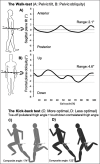A novel multifactorial hamstring screening protocol: association with hamstring muscle injuries in professional football (soccer) - a prospective cohort study
- PMID: 36247956
- PMCID: PMC9536364
- DOI: 10.5114/biolsport.2022.112084
A novel multifactorial hamstring screening protocol: association with hamstring muscle injuries in professional football (soccer) - a prospective cohort study
Abstract
The aim of this pilot study was to analyze the potential association of a novel multifactorial hamstring screening protocol with the occurrence of hamstring muscle injuries (HMI) in professional football. 161 professional male football players participated in this study (age: 24.6 ± 5.36 years; body-height: 180 ± 7.07 cm; body-mass: 77.2 ± 7.70 kg). During the pre- and mid-season, players performed a screening protocol consisting of 11 tests aimed to evaluate their performance in regards to four main musculoskeletal categories: posterior chain strength, sprint mechanical output, lumbopelvic control and range of motion. Univariable cox regression analysis showed no significant association between the isolated test results and new HMI occurrence during the season (n = 17) (p > 0.05). When including injuries that took place between the pre- and mid-season screenings (~90 days), maximal theoretical horizontal force (F0) was significantly associated with higher HMI risk between pre- and mid-season evaluations (n = 14, hazard ratio; 4.02 (CI95% 1.08 to 15.0, p = 0.04). This study identified that 1) no single screening test was sufficient to identify players at risk of HMI within the entire season, while 2) low F0 was associated with increased risk of HMI when occurring closer to the moment of screening. The present results support the potential relevance of additionally including frequent F0 testing for HMI risk reduction management. Replication studies are needed in larger cohorts for more accurate interpretations on "univariable and multivariable levels levels. Finally, future studies should explore whether improving F0 is relevant within a multifactorial HMI risk reduction approach.
Keywords: Injury prevention; Risk factors; Soccer; Sprinting.
Copyright © Biology of Sport 2022.
Conflict of interest statement
The authors have no conflict of interest to declare.
Figures




Similar articles
-
A musculoskeletal multifactorial individualised programme for hamstring muscle injury risk reduction in professional football: results of a prospective cohort study.BMJ Open Sport Exerc Med. 2024 Feb 8;10(1):e001866. doi: 10.1136/bmjsem-2023-001866. eCollection 2024. BMJ Open Sport Exerc Med. 2024. PMID: 38347859 Free PMC article.
-
Low Horizontal Force Production Capacity during Sprinting as a Potential Risk Factor of Hamstring Injury in Football.Int J Environ Res Public Health. 2021 Jul 23;18(15):7827. doi: 10.3390/ijerph18157827. Int J Environ Res Public Health. 2021. PMID: 34360125 Free PMC article.
-
A comprehensive strength testing protocol offers no clinical value in predicting risk of hamstring injury: a prospective cohort study of 413 professional football players.Br J Sports Med. 2017 Dec;51(23):1695-1702. doi: 10.1136/bjsports-2017-097754. Epub 2017 Jul 29. Br J Sports Med. 2017. PMID: 28756392
-
Sprint and jump performance in elite male soccer players following a 10-week Nordic Hamstring exercise Protocol: a randomised pilot study.BMC Res Notes. 2017 Dec 4;10(1):669. doi: 10.1186/s13104-017-2986-x. BMC Res Notes. 2017. PMID: 29202784 Free PMC article.
-
Hamstring and Ankle Flexibility Deficits Are Weak Risk Factors for Hamstring Injury in Professional Soccer Players: A Prospective Cohort Study of 438 Players Including 78 Injuries.Am J Sports Med. 2018 Jul;46(9):2203-2210. doi: 10.1177/0363546518773057. Epub 2018 May 17. Am J Sports Med. 2018. PMID: 29772188
Cited by
-
Assessment of Strength and Power Capacities in Elite Male Soccer: A Systematic Review of Test Protocols Used in Practice and Research.Sports Med. 2024 Oct;54(10):2607-2644. doi: 10.1007/s40279-024-02071-8. Epub 2024 Jul 18. Sports Med. 2024. PMID: 39026085 Free PMC article.
-
Effects of a 10-week athletic performance program on match performance variables in male professional football players.Front Sports Act Living. 2025 Jan 8;6:1496895. doi: 10.3389/fspor.2024.1496895. eCollection 2024. Front Sports Act Living. 2025. PMID: 39845508 Free PMC article.
-
Acute Changes in Hamstring Injury Risk Factors After a Session of High-Volume Maximal Sprinting Speed Efforts in Soccer Players.Sports Health. 2025 Jan-Feb;17(1):15-26. doi: 10.1177/19417381241283814. Epub 2024 Oct 6. Sports Health. 2025. PMID: 39370659 Free PMC article.
-
Validity and reliability of sprint force-velocity profiling in elite football: Comparison of MySprint, GPS, and radar devices.PLoS One. 2025 Jun 4;20(6):e0325611. doi: 10.1371/journal.pone.0325611. eCollection 2025. PLoS One. 2025. PMID: 40465815 Free PMC article.
-
Exploring the Role of Sprint Biomechanics in Hamstring Strain Injuries: A Current Opinion on Existing Concepts and Evidence.Sports Med. 2024 Apr;54(4):783-793. doi: 10.1007/s40279-023-01925-x. Epub 2023 Sep 19. Sports Med. 2024. PMID: 37725240 Free PMC article. Review.
References
-
- Hägglund M, Waldén M, Ekstrand J. Injury incidence and distribution in elite football – A prospective study of the Danish and the Swedish top divisions. Scand J Med Sci Sport. 2005; 15:21–28. - PubMed
-
- Ekstrand J, Healy JC, Waldén M, Lee JC, English B, Hägglund M. Hamstring muscle injuries in professional football: The correlation of MRI findings with return to play. Br J Sports Med. 2012; 46:112–117. - PubMed
-
- Arnason A, Sigurdsson SB, Gudmundsson A, Holme I, Engebretsen L, Bahr R. Physical Fitness, Injuries, and Team Performance in Soccer. Med Sci Sports Exerc. 2004; 36:278–285. - PubMed
-
- Ekstrand J. Keeping your top players on the pitch: the key to football medicine at a professional level. Br J Sports Med. 2013; 47:723–724.
-
- Green B, Bourne MN, Van Dyk N, Pizzari T. Recalibrating the risk of hamstring strain injury (HSI) – A 2020 systematic review and meta-analysis of risk factors for index and recurrent HSI in sport. Br J Sports Med. 2020; 54:1081–1088 - PubMed
LinkOut - more resources
Full Text Sources
